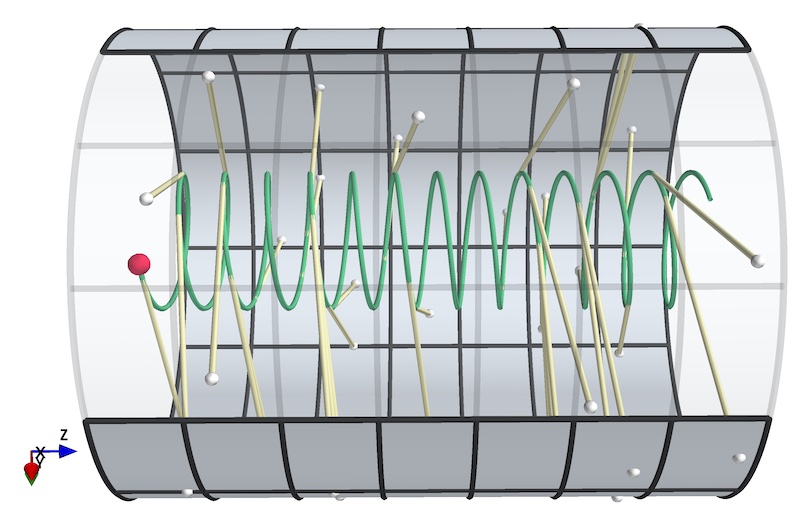Research Interests
Holographic Synchrotron Radiation Emission Spectroscopy

Fig. A simulated electron track is displayed in the HSRES detector. Photons are emitted stochastically, traveling in straight-line trajectories until impinging on the cylindrical photodetector shell. Reproduced from arXiv:2409.02878.
The direct muon decay $\mu^- N \to e^- N$ is a charged-lepton-flavor-violating (CLFV) process which is forbidden by the Standard Model of particle physics. Its observation would constitute a major development in the field. The Mu2e experiment searches for the direct muon conversion by allowing a large number of muons to decay in Aluminum and using a straw tracker to observe the decay electrons. CLFV decays are differentiated from background, electroweak decays by their decay electron energy, so the tracker measures electron energy. The experimental sensitivity to CLFV branching factors depends critically on the tracker energy resolution, but multiple scattering induced by the straws contributes to greater energy uncertainty, so we investigate the massless detector limit, where energy is determined from an electron's emitted radiation. This concept is inspired by Project 8 Cyclotron Radiation Emission Spectroscopy (CRES); however, the CLFV muon decay electrons are ultrarelativistic at $E \approx 105\,\text{MeV}$, so their emitted synchrotron radiation is qualitatively different from cyclotron radiation. To good approximation, a small number of photons are emitted tangentially by the electron, so measuring the photons on a cylindrical photodetector shell is akin to projecting the electron's trajectory onto a 2D surface. We develop "holographic" track fitting and pattern recognition algorithms to extract electron energy from the projected trajectory, and call this method Holographic Synchrotron Radiation Emission Spectroscopy (HSRES). By running numerical experiments on simulated data, we have shown a $\gtrsim 2 \times$ improvement in energy resolution. The HSRES apparatus has a number of other desirable features, so proof-of-concept prototypes are now being designed.
Relevant Publications: arXiv:2409.02878